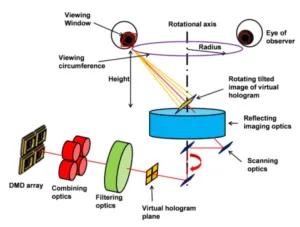A team of researchers headed by Yongjun Lim at the 5G Giga Communication Research Laboratory within the Electronics and Telecommunications Research Institute (Daejeon, South Korea) is developing a novel tabletop holographic display. The system allows multiple users to simultaneously view a glasses free, 3D image over a complete 360º range.
A recent article published by the team is entitled “360-degree tabletop electronic holographic Display.” It was published in Optics Express, 2016; 24 (22). A copy of the article is available here.
There are many challenges in developing a tabletop holographic system. Three of particular significance are as follows.
- First, the source display needs to provide an ultrahigh resolution, high speed, full color video image. In the past, this has proven difficult to achieve from the typical source, a single Digital Mirror Device. Some previous attempts to address this issue were based on spatially multiplexing multiple DMD displays. Unfortunately, this was found to make the optical system very complicated. One specific problem was the introduction of optical aberrations and distortions that, in turn, required the design and inclusion of compensations into the optical system.
- Second, in a tabletop display system, it is a practical necessity to use a highly off axis viewing circumference. In practice, the configuration of the optical system required to achieve such a system gets bulky and complex.
- Third, a large view volume is a required for a system with any hope of commercial success. Once again, this makes the required optical system quite complex.
To address these issues, the tabletop holographic display system developed by the researchers was based on a somewhat familiar starting point, the use of four synchronized high speed DMD displays. The innovation resides in the means by which these were integrated. The four DMDs were optically configured to comprise a single 2 x 2 “multi-vision panel” operated in a time multiplexed mode. By this means, it was possible to create 628 views densely positioned along the circumference of a circular viewing band having a 700 mm radius – and to do so at 20 frame per second.
The researchers then went on to design an optical image delivery sub-system that included parabolic mirrors and an aspheric lens and that served to combine, filter, magnify and scan the image. The magnification was chosen to be a factor of 2.76 so as to enlarge the holographic image to 3.2 inches. The optical system produced the image at a 45º oblique viewing angle and was intended to do so without the introduction of significant visual distortion.
As illustrated in the figure below, when the system is in operation, “observers watch the rotating tilted virtual hologram plane through the corresponding viewing window, the rotation axis of which is on the center of the top surface of the display system. Here, the tilted virtual hologram plane is normal to optical axis, so it is not tilted to optical axis but to the rotational axis. The viewing windows are positioned on the viewing circumference, where the observer’s eyes are put to accept holographic image light field.”
The configuration and operating principle of the 360 degree holographic display system. The light source is a continuous wave diode pumped solid state laser with a wavelength of 532 nm.
The system was tested by having users view computer generated holograms. The researchers report the observation of undesired artifacts such as aberration and a lower brightness from one of the DMDs. The causes of these problem are complex but understood.
In addition, “the active area of the parabolic mirror system is only less than 10% rof the parabolic mirror area when considering that the diagonal size of the virtual hologram plane is 3.2 inches and the major axis lengths of the parabolic mirrors are 22 inches. The waste of the space is a serious problem. Introduction of advanced freeform optic technology is considered as a prospected solution.”
The researchers are currently developing another version of tabletop holographic display system with the intention of solving these issues as well as producing a full color image. -Arthur Berman
5G Giga Communication Research Laboratory, ETRI, Yongjun Lim, [email protected]

